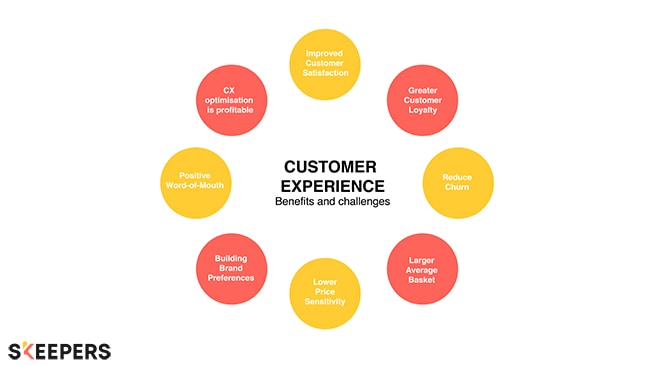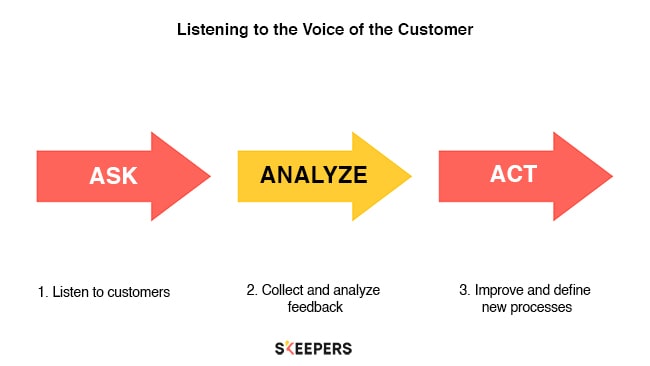Customer experience leader has become a key function in companies. According to Forrester, customer experience leaders will make up more than a third of B2B marketing functions in 2022.
So, what does this function involve? What does a customer experience leader do? What are their tasks? Read on to find out!
In 2022, 35% of B2C Marketing Functions Will be Customer Experience Leaders
“Customer experience leader” is a fairly new job title. 15 years ago, this function didn’t exist, or only in a few forward-thinking American companies (as is often the case). But things are quickly changing. In a recent report, Forrester predicted that by 2022, 35% of B2C marketing jobs will be made up of customer experience leaders.
Why Are There More and More Customer Experience Leaders?
Why? The reason is simple: customer experience has become a central issue for companies. Customer experience is no longer a buzzword. It’s key to a company’s success. Offering good quality products and services is no longer enough. In a fiercely competitive environment, you need more than a good product to stand out. You also need to improve your overall customer experience, which is far more than product satisfaction.
Customer experience has become one of the main levers for staying competitive. But there are other reasons too.
Increasingly Demanding Customers
Customers have become more demanding. They’re used to a level of service that simply didn’t exist in the past. This level of service has become the norm. Take for example, e-commerce and quick or express deliveries. Amazon has transformed long delivery times into an irritant and sometimes even a deal-breaker.
Focusing on the customer experience is therefore also a way of adapting to modern customers’ changing demands.
Companies Are Increasingly Aware of the Benefits of Customer Experience
Companies now see improving customer experience as a lever for growth. Managers are more aware of the challenges and benefits of the “Customer eXperience”, or CX:
- Improved customer satisfaction.
- Greater customer loyalty.
- Reduced churn.
- Larger average basket and, more broadly, lifetime value (the revenue that a customer generates over his or her entire life).
- Lower price sensitivity. When you have something else to offer other than good products, the price of products is no longer the only criteria that makes customers prefer one brand over another.
- Building brand preference.
- Development of positive word-of-mouth. Your customers become your main brand ambassadors.
In other words, companies are understanding that investing money in customer experience and its optimisation is profitable.
Which is why customer experience leaders have become essential.
But what is a customer experience leader’s role? What do they do? What are their tasks?

A Customer Experience Leader’s Role and Tasks
As the title suggests, a customer experience leader is in charge of overseeing the customer experience improvement process.
A Job Dedicated to Improving Customer Experience
Customer experience can be defined as a customer’s overall impression of a company. This impression is built up gradually:
- Throughout the customer’s interactions with the company at all touchpoints: customer service, website, shop, etc.
- Throughout the customer journey before, during and after a purchase.
All these interactions and steps create the customer experience.
A Customer Experience Leader is Not a Customer Relations Manager
Customer experience, customer relations, customer services… These terms sometimes get mixed up. The above definition of customer experience shows what makes them different.
Customer experience is a whole and is impacted by all the micro-experiences a customer has with a brand. Timely delivery has an impact on the customer experience. How easy it is to order a product on the company’s website has an impact on the customer experience. The speed with which a sales assistant offers to help a customer when they enter a shop is another micro-experience that impacts the overall experience. All touch points are part of the customer experience.
Customer dialogue is only one aspect of customer experience. The quality of customer service also plays a key role in customer experience, to the extent that a customer experience leader’s main task is often to make call centres more efficient. But customer experience also includes a website’s UX and a shop’s decor! Customer relations is part of the customer experience.
Customer Experience Leader, a Multi-Faceted Job
A customer experience leader is tasked with implementing actions at various touchpoints to improve the overall customer experience. A customer experience leader’s expertise consists in identifying, qualifying and prioritising the actions to be deployed in order to achieve this improvement objective. They must schedule the actions, make decisions and distinguish between quick wins and longer-term projects.
In theory, customer experience leaders should be involved in all touch points between a brand and its customers:
- In-store customer experience.
- Website customer experience.
- Customer experience with regards to customer service interactions.
- Use of product or service customer experience.
Customer experience is, by definition, omnichannel. Customer experience leaders can use 2 tools to identify which actions should be deployed first and to help organise their work.
Customer Journey Mapping and Listening to the Voice of the Customer: Two Key Customer Experience Leader Tools
A customer experience leader’s scope is very broad. In order to prioritise actions, customer experience leaders can use two very powerful tools.
Customer Journey Mapping
Customer journey mapping consists of identifying all the touchpoints between a company and its customers, in order to have an overall view of the customer experience.
There are several mapping methods available. One of them consists of:
- Representing all the stages of the journey in columns, from discovery to reactivation.
- Representing all the interaction channels used by customers and companies in rows: email, website, social media, in-store kiosks, telephone, etc.
In this model, touchpoints occur at the intersection between stages and channels. For example, “Ordering a product from the online store” is a touchpoint that occurs when the “Buy” stage intersects with the “ecommerce site” channel.
But whichever mapping method you use, the objectives are always the same:
- Gain an overall view of all touchpoints at every stage and on every channel.
- Identify key touchpoints, or moments of truth. For example, in e-commerce, the delivery of a product, as we mentioned at the beginning of this article.
- Detect problem touchpoints, otherwise known as “irritants”, that create friction on the customer journey and have a negative impact on the customer experience.
- Imagine new touchpoints or new channels to implement in order to enrich the customer experience and transform customer satisfaction into customer enchantment.
This tool is great for selecting and prioritising customer experience improvement actions. A customer experience leader’s job involves the “customer experience” but also the “customer journey”.
Listening to the Voice of the Customer
A big part of a customer experience leader’s job involves listening to customers, collecting their feedback in an organised way, and asking for suggestions and comments. They do this on different channels, at different stages of the journey and at different moments of the customer life (new customer, active customer, loyal customer, customer to reactivate).
The Voice of the Customer is the second tool that enables to identify and prioritise customer experience improvement actions.
What do customers want? What would they like the company to improve? What’s stopping them from making a purchase? What friction points have they encountered in their shopping experience? In short, what, in their opinion, are the main areas of improvement in terms of in-store experience, customer service or website navigation?
There’s only one way to get the answers to all these questions: implement a Voice of the Customer programme and tools. Skeepers offers several solutions to help you collect customer feedback and suggestions via smart surveys. We firmly believe that deploying a Feedback Management approach will improve your CX.
It’s important to use the Voice of the Customer, among other things, to steer your continuous improvement process and define your priority actions. In this sense, the Voice of the Customer, along with Customer Journey Mapping, is a valuable tool for customer experience leaders.

Customer Experience Leaders: Company Customer Spokespersons
Customer experience leaders collect the Voice of the Customer and share it with the rest of the company. They are customer spokespersons to other company departments and top management. They defend the customer’s interests, needs and expectations.
It is increasingly common practice to include a customer experience leader in workshops or on steering committees to ensure that the customer is represented and that their opinion is taken into account. Here’s a quick question: how do you spot a recent report company? Answer: in customer-centric companies, customer experience leaders take part in strategic decision-making and are members of decision-making bodies.
A customer experience leader’s functions are cross-departmental. They are often part of the marketing department, but we think it would make more sense for them to report to general management. This is an example of an initiative that makes a company truly customer-centric.
Customer Experience Leaders Play an Operational Role
As discussed above, a customer experience leader plays an important role in defining and prioritising CX areas for improvement. They actively take part in building action plans, by using available tools: customer journey mapping, voice of the customer.
But customer experience leaders also play a role in:
- Steering action plans. They monitor the deployment and implementation of improvement actions. They may even be involved in the operational implementation of certain projects.
- Selecting essential tools for managing and steering the customer experience.
A little sidenote about tools. They are essential. Two types of tools can be used to improve the customer experience:
- Activation tools, whether for marketing, sales or customer services. For example, Marketing Automation software helps create scenarios or target communications and deploy them at the right moment of the customer journey. Or Customer Service software used to manage incoming and outgoing calls, to help operators better process requests. A customer experience leader can help select these tools and deploy them within the organisation.
- Customer experience management tools, to measure and monitor the performance of company actions. The customer experience leader can help build a steering programme and select customer experience KPIs. CX Management is essential to continually improve actions and measure these actions’ ROI.
2 Inspirational Books to Find Out More and Become a Customer Experience Expert
If you’re a (future) customer experience leader and you want to gain a more in-depth understanding of the job, then we recommend reading these two books.
De kessé l’expérience client?, Daniel Lafrenière
De kessé l’expérience client? is an excellent introduction to the importance of customer experience, whether in B2C or B2B. The book is 140 pages long, clear and easy to read. The author gets straight to the point and provides practical and actionable information for companies. If you want to find out everything there is to know about customer experience, then this is the book for you.
You’ll discover what customer experience is in practical terms, why companies lose customers, 10 quick wins to improve your customer experience, good practices implemented by the best companies, how to assess your company’s existing customer experience and how to build an efficient customer experience management programme.
Comprendre la perception de vos clients pour booster votre business, Hervé Cebula, Florence Lévy
As the title suggests, this book explores the notion of customer perception. On the Skeepers blog, we often comment that customer satisfaction is key. If your customers are satisfied, loyalty will increase, along with your revenue. But customer perception comes before customer satisfaction. This is the way customers perceive the value of products and services that generate satisfaction… or dissatisfaction.
This is a thought-provoking book, which takes things one step further. We highly recommend it. The first part of the book defines the notion of “perception”, customer perception and its importance. The second part of the book, which is more “practical”, provides valuable advice on how to build a programme for the collection of customer feedback and the management of customer satisfaction (Feedback Management).
If you’re interested in finding out more, you can also take a look at:
- L’expérience client, une histoire d’émotions, Angélique Gerard.
- Satisfaction, fidélité et expérience client: Être à l’écoute de ses clients pour une entreprise performante, Christian Barbaray.
- Expérience clients – La revanche du BtoB, Céline Forest.
- La boîte à outils de l’expérience client, Laurence Chabry, Florence Gillet-Goinard & Raphaëlle Jourdan.


















